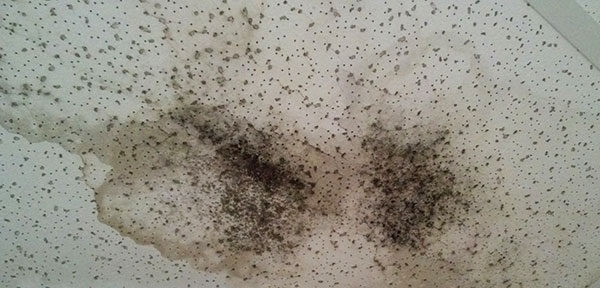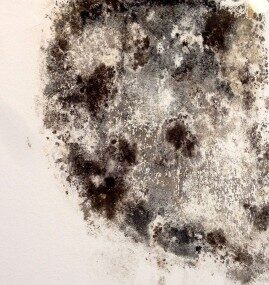Mold
What is mold? And why is it a problem?
Mold is a specific sub-group, or phylum, of the fungus kingdom. Mold breaks down dead matter, mostly cellulose like trees, leaves and such. Mold spreads by producing spores. The spores float on air currents and settle onto surfaces throughout a home. If conditions are right, mold can begin to grow and produce more spores. The right conditions include a food source, which for mold can be almost anything, and moisture. Mold must have a source of moisture to grow and reproduce, but it doesn’t take much moisture to get them growing. Even an elevated humidity level, such as in a basement or closet, can be enough. Controlling moisture is the key to controlling mold growth.
There are an estimated 300,000 mold species, most of which have not been studied or even named. Of those studied, a relatively small percentage are known to be allergenic, some are pathogenic and even fewer are known to be toxigenic. Mold spores are ubiquitous – they’re everywhere. How a person will react to any specific mold depends on how that person’s immune system reacts to the mold spores in the air. It also depends a lot on the type of mold and the level of exposure. Different people react differently to different molds, so a “safe” level of exposure to mold can never be set. Allergenic molds can elicit allergic reactions, a lot like pollen. For sensitive people, the reactions can be more serious. Toxigenic molds can do lasting damage to our bodies, including causing internal organ damage and even cancer. People with compromised immune systems are at particular risk for complications caused by mold.
How do I know if I have a mold problem?
If your home has water leaks that have gone on awhile, or has a wet or damp basement, you may have an issue with mold. If that dank, musty odor characteristic of basements is persistent, you probably have mold growing somewhere near the odor. Many molds give off volatile organic chemicals (VOCs), essentially gasses, that are responsible for that odor. As with mold spores, some of these gasses can cause adverse health effects if the exposure level is high enough. If you develop symptoms like headaches, sore throat, itchy eyes, runny nose, and so on when you’re home but not when you’re away, this can be a strong indicator that mold spore or VOC levels in your home are high.
Of course, having a professional mold specialist perform a Mold Assessment and take air samples throughout your home is the best way to determine if you have a mold concern. Through an assessment, sampling of the air and sampling any visible mold growth, the severity of the concern can be determined. The specific genus of molds found in the samples is usually identified, which can help determine if any indoor mold is of a type considered toxigenic. But again, it’s a matter of how your immune system is reacting to the mold spores and any VOCs present.
How do I get rid of mold?
Mold spores are everywhere; they’re microscopic and travel very well on air currents. There’s simply no way to make a home completely free of mold spores. The best we can do is make sure the indoor mold spore levels are less than those outdoors. If you have a mold problem, it can be taken care of by getting rid of the mold and correcting the conditions that allowed that mold to become a problem; that is, eliminating the source of moisture that’s supporting the mold growth. There are several companies that specialize in getting rid of mold and the better ones will also address the moisture concerns. These are called mold remediation companies.
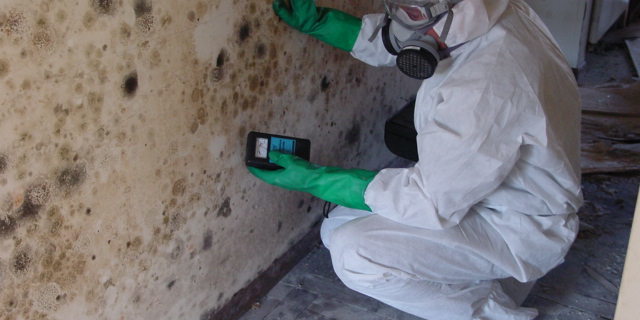
Mold Remediation and Restoration
Mold can produce allergens and irritants and has the potential to cause other health effects. Mold can spread quickly through your Lubbock home or business in as little as 48 hours. If you suspect that your home or business has a mold problem, we can inspect and assess your property. If mold is found, we have the training, equipment, and expertise to remediate your mold infestation.
Understanding Mold
Some restoration companies advertise “mold removal” and may even guarantee to remove all mold. This is a fallacy because removing all mold from a house or business is impossible; microscopic mold spores exist almost everywhere, both indoors and outdoors
Here are the facts:
Mold is present almost everywhere, indoors and outdoors.
Mold spores are microscopic and float along in the air and may enter your home through windows, doors, or AC/heating systems or even hitch a ride indoors on your clothing or a pet.
Mold spores thrive on moisture. Mold spores can quickly grow into colonies when exposed to water. These colonies may produce allergens and irritants.
Before mold remediation can begin, any sources of water or moisture must be addressed. Otherwise, the mold may return.
Mold often produces a strong, musty odor and can lead you to possible mold problem areas.
Even higher-than-normal indoor humidity can support mold growth. Keep indoor humidity below 45 percent.
Faster to Any Size Disaster
Mold spreads quickly, so a minor mold infestation can quickly escalate into a major problem. We’re dedicated to responding immediately when you contact us. A fast response lessens the damage, limits further damage, and reduces cost.
We’re Highly Trained Mold Remediation Specialists
We specialize in water and mold damage restoration, the cornerstone of our business. We have the training and expertise to safely handle any mold situation.
Applied Microbial Remediation Specialist
Water Damage Restoration Technician
Applied Structural Drying Technician
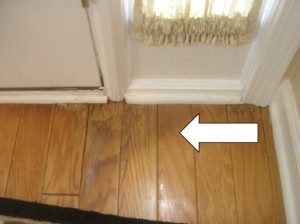
Did a home inspection turn up a “mold-like substance”?
Mold can cause symptoms like: headaches, allergies, nosebleeds and asthma. If you have unexplained illnesses and allergies and your home has had moisture problems in the past (roof leaks, plumbing leaks, excess humidity, wet carpeting), you could have a mold problem.
A Mold Inspection includes a comprehensive mold inspection, air quality testing analyzed by an independent laboratory, and a written report with an action plan and cleaning tips.
Mold Inspection Process
Are you concerned you may have mold in your home, office, or other structure? If you are worried concerning the existence of mold, or if a house assessor or other service provider has actually located mold in a structure
Visual Mold Inspection Procedure
The initial step in determining a potential mold and mildew issue is the visual inspection. Throughout this stage, we will be seeking three points: evidence of moisture leak or breach, direct proof of mold growth, and locations with a potential for mold and mildew invasion. A visual assessment will cover the interior living space, crawl, basement and also attic area or cellar. The outside of the dwelling will likewise be checked out for evidence of water harm or ecological or architectural factors that could result in moisture invasion into the house.
Surface Sampling Mold Testing
Surface area sampling is used to determine a mold kind at a certain suspect area. This strategy is also valuable in eliminating mold and mildew in areas where there is discolor ation or otherwise show mold and mildew like conditions. For this sampling method a clear tape or swab example will gather data. Product accumulated on the tape or swab will certainly be evaluated with a fungi display or culture.
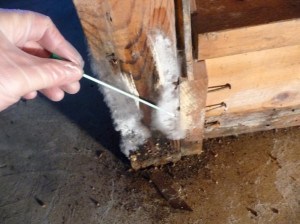
Do I Need a Mold Inspection?
Mold is one of those sneaky perpetrators that are often very successful in going unnoticed. Although mold is everywhere, and many times it may be harmless, certain types of mold can be very harmful to your health, and it is important to know what signs you should look for throughout your home to ensure there is not a dangerous mold infestation
Inspector Explains.
For all of human history, we have relied on our senses to warn us of danger, and keep us safe. In our modern day world, this still proves to be true. The first step in identifying a mold problem is generally a moldy smell. Never ignore mold odors, even if you can’t see any mold. It is important to thoroughly inspect your home before any existing mold problems get worse. A mold inspection and mold test can reveal whether there is an elevated mold level, and where it is located in your house. Although most of the time you won’t see the existing mold, your body’s symptoms my reveal you have a problem. Many cases have happened in which a patient has a health issue that they do not know the cause of but seems to be related to mold symptoms (headaches, coughing, sneezing, etc). This will often be associated with being in a certain room
On the other hand, if visible mold growth is present, sampling is unnecessary, and you just need to get it cleaned by a mold professional. However, surface sampling may be useful to determine if an area has been adequately cleaned or remediated after a mold problem has been inspected and fixed. In any case, sampling for mold should be conducted by professionals who have experience in sampling methods and interpreting any results.
Water problems have resulted in mold growth in a specific area, but that doesn’t mean you need a mold inspection. If, for example, a roof leak has resulted in moldy ceiling tiles, then fixing the roof leak and replacing the ceiling tiles may be all that is necessary. Often times, the solution is as simple as that. However, you should also consider testing for mold when there have been plumbing leaks or water issues and there is a suspicion that elevated mold may exist in the air and/or behind walls.
If your house has previously been affected by mold, it may be wise to verify that all sources of moisture have been successfully stopped and that no residual mold growth has been left after a known water and mold problem has been fixed. On this note, if you are planning on renting or purchasing a new home, it is important to get a mold inspection to confirm that there is not an existing moisture or mold problem.
Mold Remediation & Removal Services
Regardless of the cause, water damage has the potential to become a major mold situation if left unaddressed. In fact, it only takes 48-72 hours for bacteria to start to grow and mold to form As mold grows, it produces a musty odor. When these mold spores are released into the air, it can be problematic to individuals with compromised immune systems.
Mold Remediation Services
A mold infestation can create a dangerous environment that most homeowners and business owners do not know how to manage. possess the specialized equipment necessary for mold removal and structure restoration. Our teams are experienced professionals.
Analyze & Evaluate the Situation
The cleanup process begins with assessing the areas where mold is growing. Our teams employ moisture-detection tools and infrared cameras to locate cavities and hidden areas where mold, moisture, and water is present but can’t be seen.
Seal Off Rooms with Mold
Mold spreads, so our teams quickly create barriers – typically using plastic sheeting – in order to isolate areas containing mold growth. These barriers prevent mold spores from migrating to unaffected areas and starting new colonies.
Water Extraction and Water Removal
It’s important to remove all moisture and water from a home or building with mold infestation. Moisture and water create an environment that promotes mold growth, so the sooner a structure is dried out, the better.
